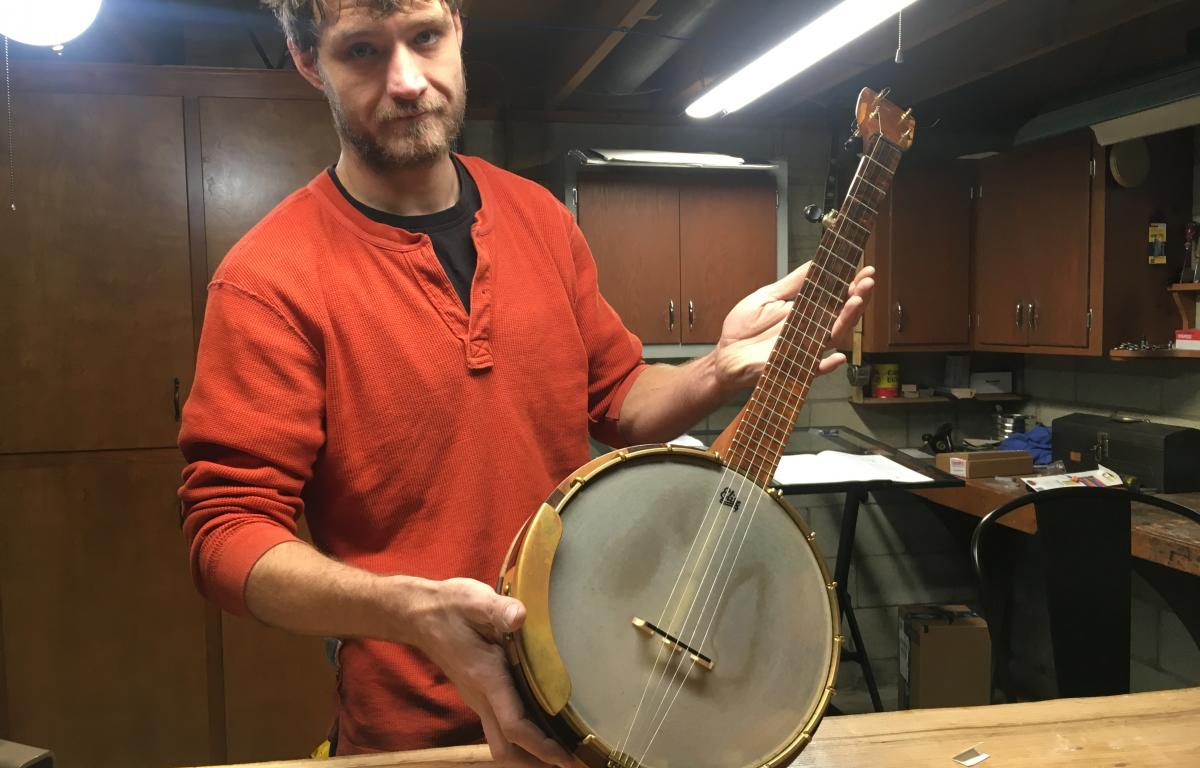
GALION — Kurt Dobbins has a way with wood.
He turns pieces of walnut, maple and ash into one-of-a-kind musical instruments. Works of art with intricate inlay and decorative hardware in four different sizes which, when played, have that instantly recognizable sound.
Dobbins builds banjos.

“It’s complex and simple at the same time. It’s not an easy instrument to build,” said Dobbins, whose workshop heated by a coal-burning stove is housed in a two-car garage adjacent to his South Boston St. home. “I like cutting stuff. It’s just what I like to do.”
The 30-year-old, a dye-maker at Covert Manufacturing Inc. in town, is also fascinated with banjos, their centuries-old history and the classic twang they emit, depending on the playing style – finger picking or the more rhythmic sound of clawhammer.
Dobbins received his first banjo – a standard Jamison – from his sister in 2015 as a graduation gift from college. He was working as a machinist in Coeur d’Alene, Idaho at the time, where two friends and fellow musicians, Frank Moore and Scott Reed, patiently helped him learn to play.

That winter, he decided to draw up the blueprints for a custom banjo, one that would better fit the size of his large hands.
“So, I started drawing. I like to engineer things, but I do it the old school way,” he said. “I like to draw it out. I like a challenge and I decided to do that.”
Using walnut and hard rock maple, Dobbins crafted his first banjo. The neck was thicker, so it resembled a guitar, but the five-string instrument was built with love – and with band saws, jack planes and specialty clamps that he also designed and built.
“I wanted to build them after I built my first one and I thought to myself, I want to do this,” said Dobbins, who moved to Galion in 2017. “I love Ohio because you can find all this incredible wood here. I like a challenge, and from an artistic standpoint, I can create something incredible.”

Now Dobbins’ workshop is brimming with banjo parts – and the specialty tools to make them. Oak, maple and ash necks with rich grains waiting for the metal frets to be pressed into the fingerboards. Bodies and buttons, rims and rings on a cherry worktable. And plenty of picks and pegs.
Dobbins even makes the brass hardware that holds the banjo neck to the body as well as the internal brace support. His string holders are ornate – silver spoons, for example, which he bends into tail pieces. His milling machine from the early 1900’s has a custom adapter plate perfect for building the bodies.
In September, Dobbins traveled to Peninsula, Ohio, to visit the Summit County workshop of another instrument maker – Doug Unger. The renowned artist/musician is widely recognized for his pearl inlay and neck carving. Dobbins left with a gift – a Windsor banjo made in Great Britain.

“I like looking at old banjos because the craftsmanship is out of the roof,” he said of the vintage pieces made in factories that no longer exist. “Old-time banjos have an open back, a style popular in the late 1880s, and have more of a mountain style sound. With a resonator plate you get a bluegrass style music.”
Dobbins said one of his favorite banjo woods is Spalted maple, which he finds along the Kokosing River. During hikes he also has picked up oak from the river’s muddy banks and logs from the Mohawk Dam in Coshocton County, some of which is curing under a tarp in the backyard.
Dobbins, who has more than 20 banjos in the rough stages with three more nearly finished, estimates he spends more than 100 hours tediously crafting each one, with price tags starting at $2,500 per instrument. But the self-taught artist has found his passion.
“I can’t explain the driving force,” said Dobbins, who spends four to six hours a day tinkering in his workshop before heading into his second-shift job. “This is the place to be. It’s something I enjoy, and it gives me a medium in which to think. It’s great fun and it’s challenging.”
























